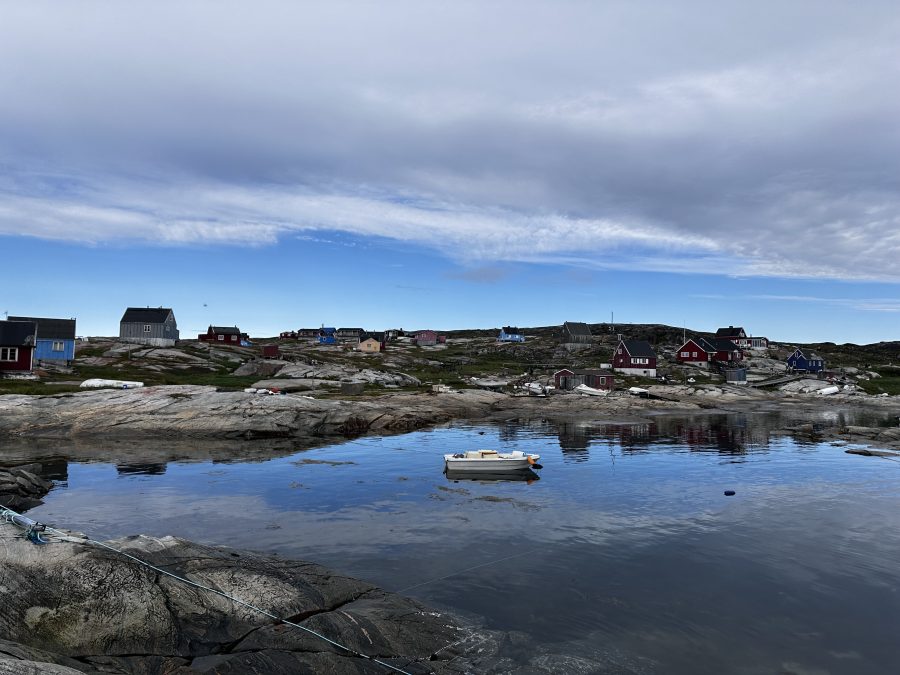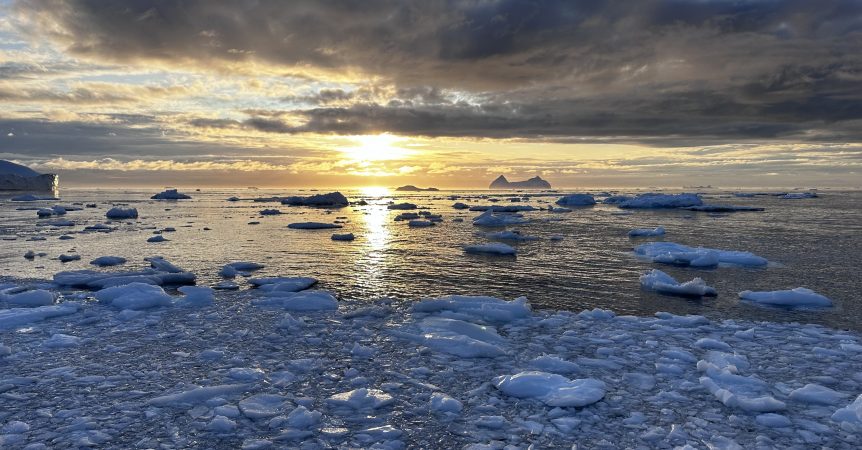Image: Ilulissat, Greenland, 2023, by Line Larsen
Broadening Perspectives when Teaching about the Greenland Ice Sheet
Apr 14, 2025
With the current spotlight on Greenland, we invited our partner, Dr. Michelle Koutnik, a glaciology research faculty member at the University of Washington's College of the Environment, to offer her perspective to help illuminate some of the interconnected and complex issues that go beyond the media headlines. She kindly shared some relevant background, current information, and helpful resources as she prepares herself and her students for another Scan Design Foundation-funded trip to study the effects of climate change on the Greenland Ice Sheet this summer.

I teach and co-lead classes about the Greenland Ice Sheet and the Arctic, including a study abroad course to Greenland. As a glaciologist who studies glaciers and ice sheets, I have contributed to field studies and I have traveled in the west and east of Greenland numerous times in the past 20 years.
I am preparing to co-lead an interdisciplinary study abroad course supported by Scan Design Foundation (SDF) for 10 undergraduate students and 3 graduate students, where we will explore and engage in Greenland for two weeks starting in late August of this year, and a subset of the students will also travel to Denmark for one week. The course focuses on the ice environment of Greenland, as well as engages students in aspects of policy, government, society, culture, and history; SDF has shared reflections from the 2023 course. We travel and learn from the environment and life in Greenland with utmost respect for the people and place, and we also engage with leaders in research, sustainability, history, and energy policy in Denmark for a broader perspective about Arctic ice, climate, and Danish-Greenlandic relations. In addition to preparing for the study abroad course, I am also currently teaching an interdisciplinary Honors course at University of Washington that explores the past, present, and future state of the Greenland Ice Sheet.

These courses are interdisciplinary, aiming to bring together different areas of knowledge as well as different ways of knowing. Integrated understanding of environmental, socioeconomic, cultural and political changes in the Arctic in contemporary and historical contexts is critical to addressing real-world challenges faced locally and globally. As the Arctic air temperature currently warms four times faster than the global average, the environmental issues we face include amplifying the rate of sea ice loss, melting of glaciers and the Greenland Ice Sheet, rising sea levels, thawing of permafrost, and increasing wildfire occurrence. Change is fundamental not only to the Arctic climate and environment but also to societies that live in and interact with the Arctic. In particular, the lives and livelihoods of Indigenous Peoples and Arctic residents are profoundly impacted by changes in the landscape and ecology, and also by geopolitical issues of Arctic access and use. Integrated understanding of the Arctic requires thinking critically across disciplines.
While my courses focus around the Greenland Ice Sheet, it is necessary to gain a broader understanding of the Arctic and perspectives on the current geopolitical landscape where the country of Greenland is central. This landscape is rapidly evolving, and while many perspectives are important, the selected points below are ones that I recommend to consider at this moment. Note that these sources are all in English, but each is rich with additional links and information, and I encourage reading the linked articles.
The Arctic is circumpolar, where the geography, homelands of Indigenous Peoples, and governance are connected, as well as have been cooperative. As a part of place-based learning in classes, we explore the Native Land Viewer that “honors the sovereignty of all Indigenous nations, their lands, and their waters”, including across the Arctic. In decision-making, the Arctic Council is an “intergovernmental forum promoting cooperation”, and the Inuit Circumpolar Council has representation on the Arctic Council as a “united voice” representing approximately 180,000 Inuit living in the Arctic. Scientific research can also be a mechanism for cooperation, and the International Arctic Science Agreement was enacted in 2018 by eight Arctic governments and facilitates access to place and data, as well as use of equipment, materials, and research infrastructure. Those who are not familiar with Greenland can learn about Greenland’s history, including governance and relationship with Denmark. In addition, photojournalism shares views from Greenlandic life, culture, and environment.

Given current events, what is the geopolitical significance of Greenland to the United States? Some of the key issues include power dynamics in broader Arctic geopolitics, United States military capabilities, future trans-Arctic shipping, critical minerals, oil and gas, freshwater, and fisheries; this explainer by the Belfer Center discusses these in more detail. This piece concludes by stating, “It is for Greenlanders to decide the future of Greenland. The United States does not need to own Greenland to achieve its security and economic interests, and Trump’s current approach may be counterproductive to those interests. His threats may have the unintended consequences of alienating Greenland, the Kingdom of Denmark, and other U.S. allies and undermining both a long tradition of cooperative Arctic governance and the existing norms of the current international system.” Analysis by the Center for Strategic and International Studies also emphasizes that the United States seizing Greenland is a bad deal, actually it is “worse than a bad deal”.
“Greenland is not for sale. And it never will be.” Greenlandic governance and Inuit priorities need to be followed, but there is a risk that they will not be respected, which has been emphasized by Inuit leaders. Greenland had an election in March 2025, and a different political party, one that favors seeking independence on a longer timeline, is leading in establishing the next government. Actions by the United States are seen as increasingly aggressive. Even so, the United States continues to try to persuade Greenland to make a deal.
Greenland’s ice and environment, as well as whether perceived economic opportunities could ever become reality, all need to be a more central part of the discussion. Most critical is limiting loss of the Greenland Ice Sheet – and this is what is strategic to national security – as sea-level change has a global impact, and our actions now are determining our future. And, an economic boom from mining has not yet occurred in Greenland. Critical mineral mining may be promising in some locations, but access is challenging and safeguarding the environment is necessary. In addition to the wintertime temperature and ice cover, the summertime melting of ice and steep fjord topography that is prone to landsliding make minerals “dangerous to extract”. And, we need to consider that the United States could already have opportunities for mining in Greenland, has already been assessing critical mineral potential in Alaska, and through Alaska the United States already has a seat in the Arctic.

Greenland has hosted the U.S. military since World War II. Currently the Pituffik Space Base remains active on the northwest coast of Greenland. The United States Department of Defence released an Arctic Strategy in 2024, expressing that the rapid changes in the Arctic (due to climate change), as well as strategic international interest in the Arctic, could be a threat to our national security. The strategy emphasizes working with Allies, and the Government of Greenland released Greenland’s Foreign, Security and Defense Policy in 2024: “Greenland in the World: Nothing about us without us” and a new agreement strengthens the presence of the Danish Defence in the Arctic and North Atlantic region (January 2025). There are military strategies in place, and developing.
When talking with students I emphasize that a range of perspectives is necessary in order to put news headlines in a broader context. Hopefully this helps to deepen an understanding about current events, which are significant and complex. This is a conversation that I am having in my classes, and I urge thinking and talking about these issues widely as attention on Greenland and the Arctic continues. Jens-Frederik Nielsen, the Prime Minister of Greenland, recently stated “we must respond with peace, dignity, and unity” – we should all stand for these values.

